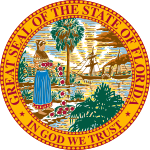Elections in Florida
| Elections in Florida |
|---|
 |
|
|
Elections in the U.S. state of Florida are held on the first Tuesday after the first Monday of November in even-numbered years, as provided for in Article 6 of the Florida Constitution.[1]
Voter qualifications
All citizens of the United States, over the age of eighteen and who are permanent residents of the state, may register to vote as a qualified elector of Florida unless they are convicted of a felony or found to be mentally incompetent.
State elections
The Governor of Florida, Lieutenant Governor, and the members of the Florida Cabinet are elected every four years. Members of the Florida House of Representatives are elected every two years, while members of the Florida Senate are elected every four years. Candidates for the Florida legislature may serve no more than eight years in either house.
Florida in national elections
Florida received international attention for its role in the 2000 presidential election, where George W. Bush led Al Gore by only a couple of hundred votes when the Supreme Court of the United States ended a recount. It had also played a role in the equally contested 1876 presidential election and is often seen as one of the key swing states in presidential elections.[2]
Florida held its 2008 presidential primary on January 29, 2008 after a bill was passed in May 2007 moving it sooner on the electoral calendar.[3] This move was in violation of party rules restricting primaries held before February 5 to Iowa, Nevada, New Hampshire, and South Carolina. The Democratic Party eventually decided to strip Florida of all its 210 delegates at the Democrats' convention, while the Republicans stripped Florida of half its delegates to the GOP convention. A federal judge dismissed a suit from Democratic Senator Bill Nelson against the DNC and chairman Howard Dean to overturn this decision.[4]
History
In the first half of the 19th century, the right to vote was held only by white males aged 21 and over. After 1920, women were able to vote with the passing of the Nineteenth Amendment to the United States Constitution. In 1937, the requirement to pay a poll tax was repealed by the state legislature, allowing poorer Floridians to vote, and in 1944 the United States Supreme Court invalidated a system of white-only primary elections.[5]
In 1966, Claude Kirk was elected the first Republican governor of Florida since Reconstruction.[6]
In 1972, 69% of Florida voters registered as Democrats, 28% Republican, and 3% other. in 1992, Democratic registration was 51%, Republicans 41%, and 8% other. In 2013, Democrats registered 40%, Republicans 35%, and 25% other.[7]
See also
- Government of Florida
- Politics of Florida
- Florida elections, 2010
- Political party strength in Florida
References
- ^ The Florida Constitution
- ^ Parties struggle to control primaries
- ^ Early primary gives Florida a big say in '08 vote
- ^ Judge dismisses primary date lawsuit Miami Herald, December 6, 2007
- ^ A Brief History of Florida
- ^ Florida:Timeline
- ^ Dockery, Paula (October 19, 2013). "In the middle sits a silent majority". Florida Today. Melbourne, Florida. pp. 13A. Retrieved October 19, 2013.
External links
- Florida Division of Elections government website
- Florida Elections Commission government website
- Florida at Ballotpedia
